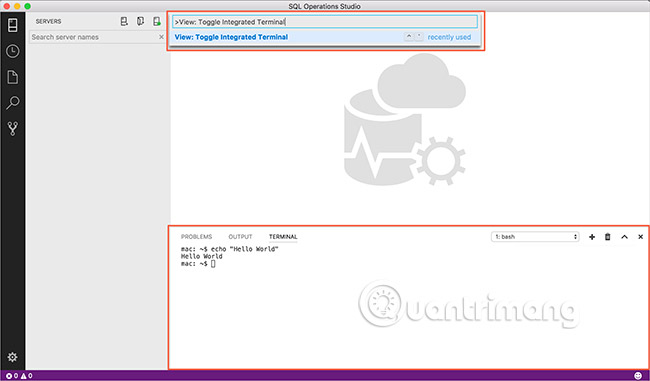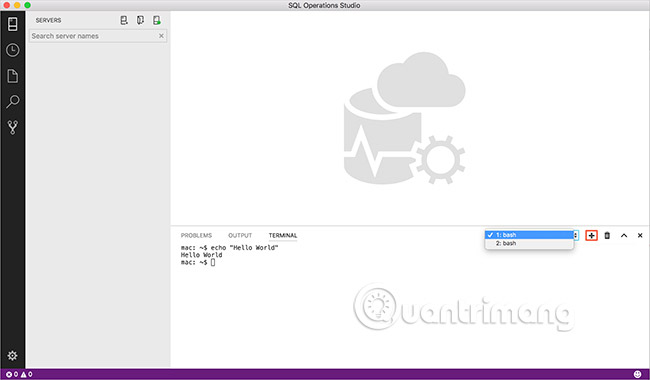Integrated terminal in SQL Operations Studio (preview)
In SQL Operations Studio (preview), you can open an integrated terminal, starting from the root of the current workspace. This can be convenient because you do not have to switch the windows or change the status of the current terminal to execute the command line task quickly.
Integrated terminal in SQL Operations Studio (preview)
- Open the terminal
- Manage multiple terminals
- Configuration
- Windows
- Argument Shell
- Settings show terminal
- Bind the keys in the terminal
- Run the selected text
- Copy and paste
- Search
- Change the name of the terminal session
- Forced to assign the right keys over the terminals
Open the terminal
To open the terminal:
- Use keyboard shortcut Ctrl + ` .
- Use the View | command Integrated Terminal menu .
- From the Command Palette (Ctrl + Shift + P) , use the View command : Toggle Integrated Terminal.

Note : You can still open an external shell with Explorer Open in Command Prompt (open in Terminal on Mac or Linux), if you prefer to work outside of SQL Operations Studio (preview).
Manage multiple terminals
You can create multiple terminals in different locations and easily navigate between them. You can add terminals by clicking the plus icon at the top right of the TERMINAL control panel or by activating the Ctrl + Shift + ` command. This creates another entry in the list, which can be used to switch between terminals.

Delete the terminal by pressing the Trash button .
Tip: If you use multiple terminals, you can add the main constraints for focusNext, focusPrevious and kill commands listed in the " Binding keys in the terminal " section below, to allow navigation between the terminals with only keyboard.
Configuration
Shell is used by default as $ SHELL on Linux and macOS, PowerShell on Windows 10 and cmd.exe on previous versions of Windows. They can be manually overwritten, by setting the terminal.integrated.shell. * In the settings. The arguments can be transferred to terminal shell on Linux and macOS, using the terminal settings.integrated.shellArgs . * .
Windows
Properly configure your shell on Windows including locating the appropriate executable file and updating the settings. Below is a list of common shell executables and their default locations:
// 64-bit cmd if available, otherwise 32-bit
"terminal.integrated.shell.windows": "C: Windowssysnativecmd.exe"
// 64-bit PowerShell if available, otherwise 32-bit
"terminal.integrated.shell.windows": "C: WindowssysnativeWindowsPowerShellv1.0powershell.exe"
// Git Bash
"terminal.integrated.shell.windows": "C: Program FilesGitbinbash.exe"
// Bash on Ubuntu (on Windows)
"terminal.integrated.shell.windows": "C: Windowssysnativebash.exe"
Note : To be used as an integrated terminal, the executable shell must be a console application so stdin / stdout / stderr can be redirected.
Tip : Shell integrated terminal is running with the rights of SQL Operations Studio (preview). If you need to run shell commands with advanced admin rights or different permissions, you can use platform utilities like runas.exe in a terminal.
Argument Shell
You can pass arguments to the shell when it is started.
For example, to allow bash to run as a login shell (run .bash_profile), switch in the -l argument (with quotation marks):
// Linux
"terminal.integrated.shellArgs.linux": ["-l"]
Settings show terminal
You can customize the font and line height for the integrated terminal with the following settings:
-
terminal.integrated.fontFamily
-
terminal.integrated.fontSize
-
terminal.integrated.lineHeight
Bind the keys in the terminal
View command : Toggle Integrated Terminal is linked with Ctrl + ` to quickly switch the terminal control panel built-in and out of sight.
Here are the shortcuts for quick navigation in the integrated terminal:
Command key combination Ctrl + `Integrated terminal display Ctrl + Shift +` Create new terminal Ctrl + Up Scroll up Ctrl + Down Scroll down Ctrl + PageUp Scroll page Ctrl + PageDown Scroll down page Ctrl + Home Scroll to the top of the page Ctrl + End Scroll to the bottom of the page Ctrl + K Delete the terminalOther terminal commands are available and can be assigned with your favorite shortcuts, including:
- workbench.action.terminal.focus: Focus on the terminal. This is like a conversion but focuses on the terminal instead of hiding them, if the user can see them.
- workbench.action.terminal.focusNext: Focus on the next terminal instance.
- workbench.action.terminal.focusPrevious: Focus the previous instance instance.
- workbench.action.terminal.kill: Remove the current terminal instance.
- workbench.action.terminal.runSelectedText: Run the selected text in the terminal.
- workbench.action.terminal.runActiveFile: Run the active file in the terminal.
Run the selected text
To use the runSelectedText command , select the text in an editor and run the Terminal command : Run Selected Text in Active Terminal through the Command Palette (Ctrl + Shift + P) . Terminal will run the selected text:

If no text is selected in the active editor, the line that the cursor is set to is run in the terminal.
Copy and paste
Assigning keys to copy and paste conform to platform standards:
- Linux: Ctrl + Shift + C and Ctrl + Shift + V
- Mac: Cmd + C and Cmd + V
- Windows: Ctrl + C and Ctrl + V
Search
The integrated terminal has a basic search function that can be activated with Ctrl + F.
If you want Ctrl + F to go to the shell, instead of launching the search utility on Linux and Windows, you need to delete the key link as follows:
{"key": "ctrl + f", "command": "-workbench.action.terminal.focusFindWidget",
"when": "terminalFocus"}, Change the name of the terminal session
Integrated terminal sessions can be renamed using the Terminal command : Rename (workbench.action.terminal.rename) . The new name is displayed in the terminal selection menu.
Forced to assign the right keys over the terminals
While the focus is on the integrated terminal, many of the key keys assigned will not work, because key combinations are transmitted and are suppressed by the terminal itself. Terminal.integrated.commandsToSkipShell setting can be used to do this. It contains an array of command names with assigned keys, bypassing shell processing and instead is handled by the system binding SQL Operations Studio (preview) keys. By default, this includes all the keys assigned in the terminal, adding some commonly used key options.
See more:
- Check constraints in SQL Server
- Unique constraints in SQL Server
- How to completely uninstall SQL Server
You should read it
- 8 best free Terminal Emulator apps for Android
- 18 terminal commands on Chromebook you should know
- Notable changes in Windows Terminal ver 0.11
- How to fix the problem of being unable to enter Terminal in Linux
- How to customize Windows Terminal application
- Top 5 useful Terminal tips for Mac users
- 6 ways to fix Windows Terminal not opening error
- How to reset Windows Terminal to default settings on Windows 10
May be interested
- 6 interesting terminal commands on Mac
 terminal is a handy utility, often found on unix-based computers, such as linux and macos. there are many interesting things to do in the terminal. regardless of your experience, you can use these great terminal commands on mac.
terminal is a handy utility, often found on unix-based computers, such as linux and macos. there are many interesting things to do in the terminal. regardless of your experience, you can use these great terminal commands on mac. - Keyboard shortcuts in Visual Studio - All common keyboard shortcuts in Visual Studio
 visual studio is a very popular programming tool because it was developed by the giant microsoft with a friendly, lightweight interface. to help with the coding process, using keyboard shortcuts will help you to minimize time and redundant operations.
visual studio is a very popular programming tool because it was developed by the giant microsoft with a friendly, lightweight interface. to help with the coding process, using keyboard shortcuts will help you to minimize time and redundant operations. - Visual Studio Code review: Microsoft's cross-platform code editor
 visual studio code is a lightweight but powerful code editor running on computers, available for windows, macos and linux. vscode comes with integrated support for javascript, typescript and node.js.
visual studio code is a lightweight but powerful code editor running on computers, available for windows, macos and linux. vscode comes with integrated support for javascript, typescript and node.js. - How to use Terminal on a Mac
 terminal on mac is a command line interface that allows you to use unix commands to complete some tasks much faster than using a graphical user interface (gui). with the terminal command, you can open files, improve your mac's performance, and more. here's how to use terminal on mac, including some basic commands you can get started.
terminal on mac is a command line interface that allows you to use unix commands to complete some tasks much faster than using a graphical user interface (gui). with the terminal command, you can open files, improve your mac's performance, and more. here's how to use terminal on mac, including some basic commands you can get started. - Some shortcuts need to be remembered in Windows 10 Technical Preview
 if you've just successfully installed windows 10 and want to experience everything on this new version of windows, you'll want to learn through the newly integrated keyboard shortcuts. here are some pretty interesting shortcuts that you should remember.
if you've just successfully installed windows 10 and want to experience everything on this new version of windows, you'll want to learn through the newly integrated keyboard shortcuts. here are some pretty interesting shortcuts that you should remember. - Windows Terminal adds a tool to edit hidden graphics settings
 windows terminal is an open source application developed by microsoft that allows you to open multiple console tabs in the same windows. each of these dashboard tabs can be used for different shells.
windows terminal is an open source application developed by microsoft that allows you to open multiple console tabs in the same windows. each of these dashboard tabs can be used for different shells. - 8 best free Terminal Emulator apps for Android
 terminal emulator applications on android are handy when you want to execute commands within the android operating system just like on linux.
terminal emulator applications on android are handy when you want to execute commands within the android operating system just like on linux. - 6 notable differences between Mac Studio and Mac Pro
 apple has unveiled two compelling desktops for creative professionals: the mac studio and the mac pro, both featuring apple's most advanced silicon chips.
apple has unveiled two compelling desktops for creative professionals: the mac studio and the mac pro, both featuring apple's most advanced silicon chips. - Roblox Studio
 what is roblox studio? roblox studio is a freeware program that gives you the ability to create personalized video games and play other games created by the community.
what is roblox studio? roblox studio is a freeware program that gives you the ability to create personalized video games and play other games created by the community. - 12 Apps Windows 11 Users Should Install on Their New PC
 here are 11 apps you should have on microsoft's new operating system. these apps improve on existing features or add what windows 11 lacks (and they work just as well on windows 10).
here are 11 apps you should have on microsoft's new operating system. these apps improve on existing features or add what windows 11 lacks (and they work just as well on windows 10).










 The LIKE command in SQL
The LIKE command in SQL TOP command in SQL
TOP command in SQL ORDER BY command in SQL
ORDER BY command in SQL GROUP BY command in SQL
GROUP BY command in SQL DISTINCT keyword in SQL
DISTINCT keyword in SQL Sort results in SQL
Sort results in SQL